| | | OFFLINE | | Post: 26.020
Post: 8.512 | Registrato il: 28/08/2005
Registrato il: 20/01/2009 | Administratore | Utente Master | |
|

 GENERAL AUDIENCE
GENERAL AUDIENCE
January 2, 2013
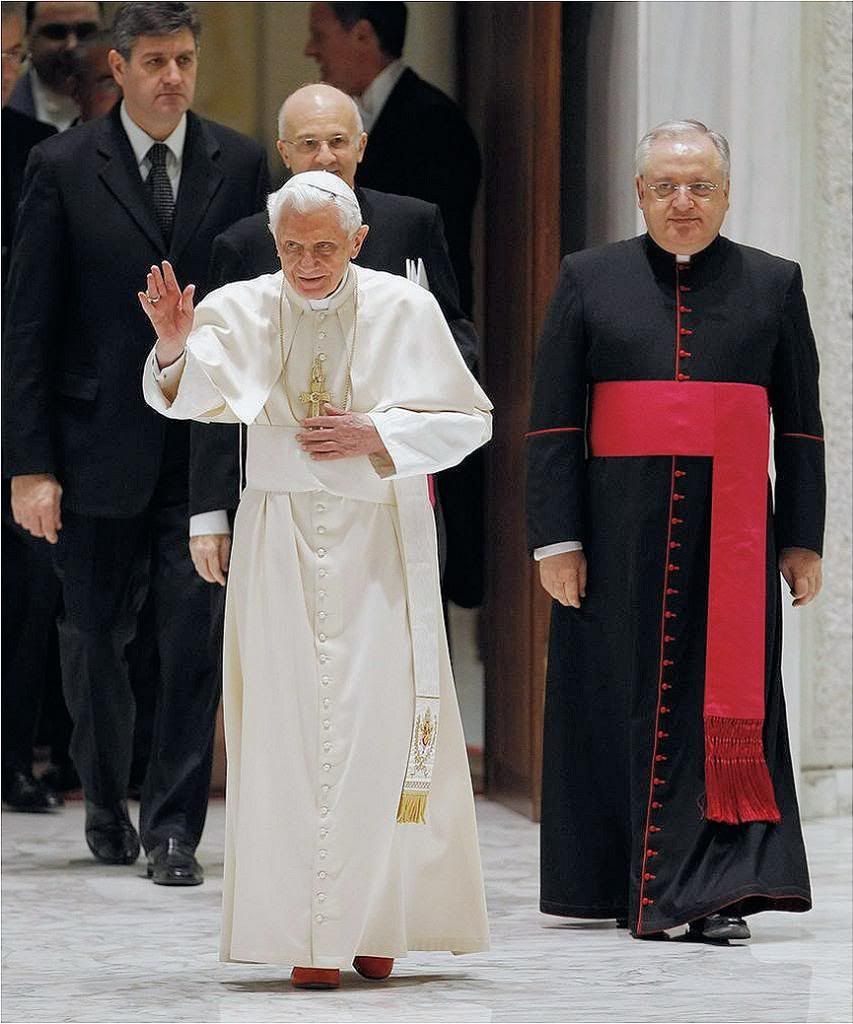
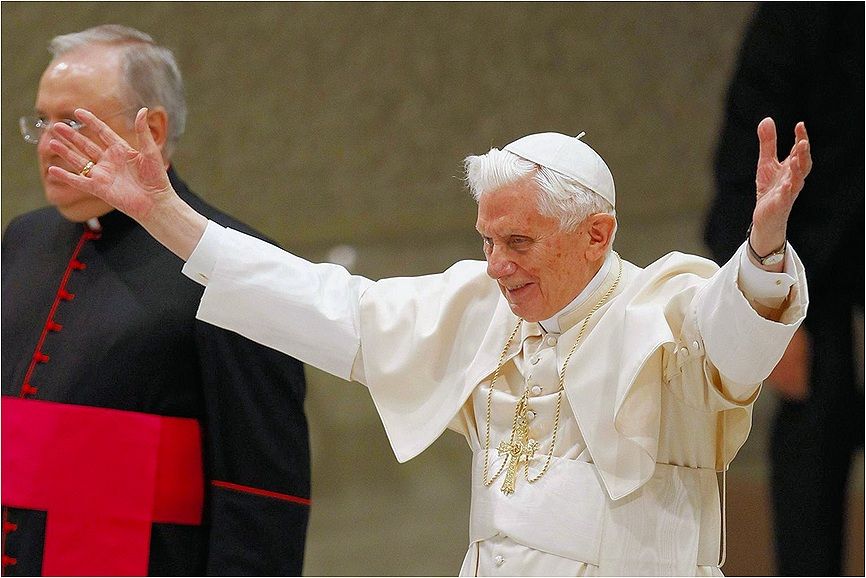
At his first General Audience for 2013, Pope Benedict XVI's catechesis reprised the premise with which he starts The Infancy Narratives: What is Jesus's origin?, as an approach to establishing the identity of Jesus Christ. In English, he said:
In this Christmas season, we rejoice in the light which surrounds Christ’s birth, bringing a hope which transforms our life in this world.
Each year our celebration leads us to reflect anew on Jesus's identity as the only-begotten Son of God, who became man for our salvation. Jesus is truly Emmanuel: "God among us", born of the Virgin Mary.
When we profess the mystery of the incarnation in the Creed, we bow our heads in awe and adoration. We acknowledge that the incarnation is the work of the three Persons of the Blessed Trinity, brought about through Mary’s free cooperation.
The incarnation is the beginning of the new creation. Conceived by the power of the Holy Spirit, Christ is the new Adam who offers humanity rebirth in the waters of Baptism, by which we become sons and daughters of our heavenly Father.
During this holy season, may we welcome the Saviour into our hearts, allow God’s power to strengthen and transform our weakness, and bear joyful witness to the dawning of the new creation.

Here is a translation of the Holy Father's catechesis today:
Dear brothers and sisters,
The Nativity of the Lord illuminates once more with its light the shadows that often envelop our world and our hearts, to bring hope and joy.
Where does this light come from? From the cave in Bethlehem where the shepherds found Mary and Joseph and the baby laid in a manger (Lk 2,16).
Another more profound question arises when we contemplate this Holy Family: How could that small and helpless Baby have brought such a radical novelty to the world that changed the course of history? Was there not something mysterious in his origin that went far beyond that cave?
Thus, the question on the origin of Jesus arises again and again - the same question that the Roman procurator Pontius Pilate asked during the trial of Jesus: "Where are you from?" (Jn 19,9).
And yet the origin of Jesus is quite clear. In the Gospel of John, when the Lord declares, "I am the bread descended from heaven", the Jews reacted, murmuring to themselves: “Is this not Jesus, the son of Joseph? Do we not know his father and mother? Then how can he say, ‘I have come down from heaven’?” (Jn 6,42).
Not long afterwards, the citizens of Jerusalem would forcefully protest against the alleged messianicity of Jesus, saying "We know where he is from. When the Messiah comes, no one will know where he is from” (Jn 7,27).
Jesus himself points out how inadequate is their alleged claim to know his origin, and thus he already offers an orientation for knowing where he comes from: "I did not come on my own, but the one who sent me, whom you do not know, is true" (Jn 7,28). Of course, Jesus came from Nazareth, he was born in Bethlehem, but what did they know of his true origin?
The answer to the question "Where did Jesus come from?" emerges clearly in all four Gospels: His true origin is God the Father - he comes totally from him but in a way that is unlike any prophet or messenger of God that preceded him.
This origin of the mystery of the God 'whom no one knows' is already found in the infancy accounts of Matthew and Luke what we have been reading during the Christmas season.
The angel Gabriel announces, “The holy Spirit will come upon you, and the power of the Most High will overshadow you. Therefore the child to be born will be called holy, the Son of God." (Lk 1,35).
We repeat these words everytime we recite the Credo, our profession of faith: «et incarnatus est de Spiritu Sancto, ex Maria Virgine» - through the Holy Spirit, he was incarnated in the womb of the Virgin Mary.
At these words, we kneel because the veil which had hidden God has been opened, so to speak, and his unfathomable and inaccessible mystery now touches us: God became Emmanuel, God-with-us.
When we hear the Masses composed by the great masters of sacred music - for example, Mozart's Coronation Mass - we immediately note how they dwell particularly on this phrase, almost as if they were seeking to express with the universal language of music what words cannot manifest: the great mystery of God who becomes incarnated and makes himself man.
If we consider the expression "conceived of the Holy Spirit, born of the Virgin Mary", we find that it has four subjects acting. The Holy Spirit and Mary are explicitly mentioned, but He - the Son - who became flesh in the womb of the Virgin, is implicit [as is his Father].
In the Nicean-Constantinopolitan version of our profession of faith, the Credo, Jesus is referred to by various appellatives: Lord, Christ, the only-begotten Son of God, God from God, Light from Light, true God from true God, consubstantial with the Father.
Thus we see that he is referred to another person, the Father. The first subject of the phrase is therefore the Father who, with the Son and the Holy Spirit, is the one God.
This statement in the Credo does not refer to God's eternal being, but rather speaks of an action in which the three divine Persons take part and which is realized ex Maria Vergine - through the Virgin Mary.
Without her, God's entry into the history of mankind would not have been achieved, and the central fact in our Profession of Faith would not have taken place, namely, God who became God-with-us.
Thus Mary belongs irrevocably to our faith in a God who acts and enters our history. She placed her whole being at God's disposition and accepted to become the place of God's dwelling.
Sometimes, during our journey and life of faith, we become aware of our poverty, of our inadequacy, in the face of the witness that we must bear to the world. But God chose a humble girl from an obscure village in one of the most remote provinces of the Roman Empire to give birth to his Son.
Always, even in the midst of the most arduous difficulties we face, we must trust in God, renewing our faith in his presence and action in our history, as in that of Mary. Nothing is impossible to God. With him, our existence always moves along secure ground and is open to a future of firm hope.
By professing in the Creed, "conceived of the Holy Spirit and born of the Virgin Mary", we affirm that the Holy Spirit, as the power of God Most High, achieved mysteriously in the Virgin Mary the conception of the Son of God.
The evangelist Luke reports the words of the archangel Gabriel: “The holy Spirit will come upon you, and the power of the Most High will overshadow you" (1,35).
Two Biblical references are evident: The first is to the moment of creation. At the start of the Book of Genesis, we read that "he Spirit of God moved over the waters" (1,2) - it is the Creator Spirit who has given life to all things and to the human being.
This happens to Mary, through the action of the same divine Spirit. It is a new creation: God who called being out of nothing, gives life to a new beginning for mankind with the Incarnation. The Fathers of the Church often spoke of Christ as the new Adam, to underscore the start of a new creation with the birth of the Son of God from the womb of the Virgin Mary.
This makes us reflect on how faith itself brings us a novelty so great that it results in our rebirth. Indeed, we begin our life as Christians with Baptism, which makes us reborn as children of God, and makes us take part in the filial relationship that Jesus has with the Father.
I would like to point out that Baptism is received - we are baptized - it is a passive action, because no one is capable of making oneself a child of God. It is a gift that is conferred freely.
St. Paul refers to this adoptive filiality of Christians in a central passage of his Letter to the Romans, where he writes: "Those who are led by the Spirit of God are children of God. For you did not receive a spirit of slavery to fall back into fear, but you received a spirit of adoption, through which we cry, 'Abba, Father!' The Spirit itself bears witness with our spirit that we are children of God" (8,14-16), not servants.
Only if we open ourselves to God's action, as Mary did, only if we entrust our life to the Lord as a friend in whom we have complete trust, only then shall our lives acquire new meaning and a new face: that of children of a Father who loves us and will never abandon us.
We spoke of two elements in the Annunciation - the first was of the Spirit moving over the waters, the Creator Spirit. There is another element in the words of the Annunciation.
The angel says to Mary: "The power of the Most High will overshadow you". It is a reference to the sacred cloud that, during the Exodus journey, posed over the tent of the Covenant, over the Ark of the Covenant that the people of Israel carried with them and which indicated the presence of God (cfr Ex 40,40,34-38).
Mary is thus the new sacred tent, the new Ark of the Covenant. With her Yes to the words of the Archangel, God received a dwelling in this world. He whose infinity the world cannot contain pitched his dwelling in the womb of a virgin.
Let us get back to the question with which we set out - that of the origin of Jesus, synthesized by Pilate's question, "Where are you from?" In our reflections, it is clear, from the very start of the Gospels, what the true origin of Jesus is: He is the only Son of the Father. He comes from God.
This is the great and overwhelming mystery that we celebrate at Christmastime: The Son of God, through the work of the Holy Spirit, was incarnated in the womb of the Virgin Mary.
This is the announcement that always sounds new, and which brings hope and joy to our hearts, because everytime, it gives us the certainty that even if we often feel weak, poor, incapable in the face of the difficulties and evils of the world, the power of God is always at work and produces wonders even in weakness. His grace is our strength (cfr 2 Cor 12,9-10). Thank you,
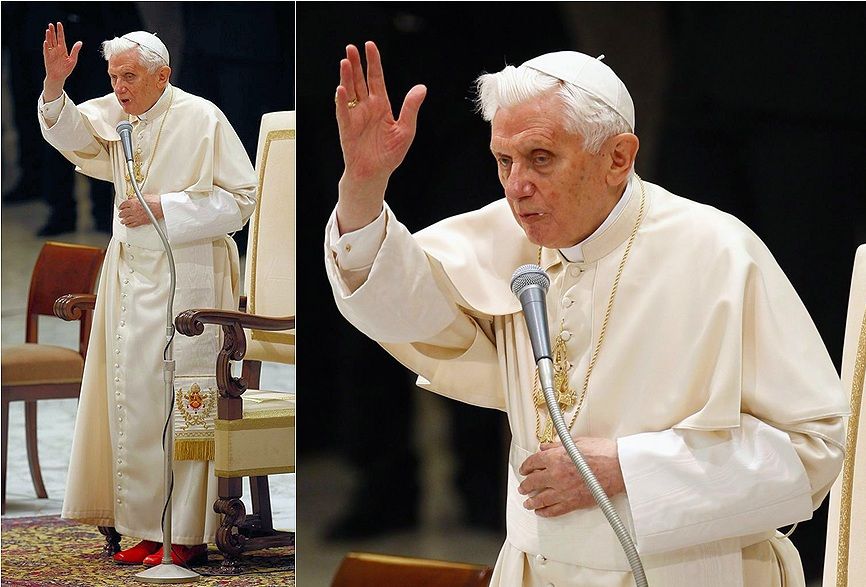
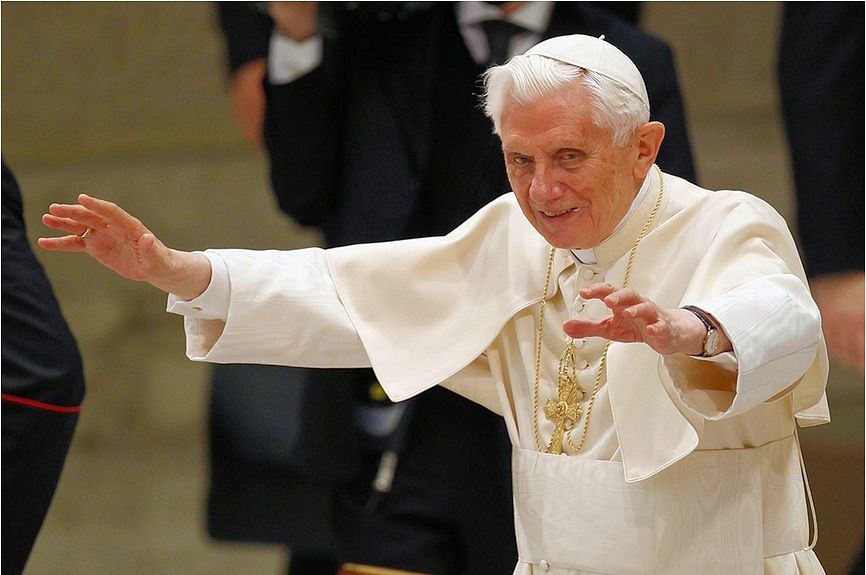

![[SM=g8115]](https://im0.freeforumzone.it/up/0/15/1119870.gif) ![[SM=g8115]](https://im0.freeforumzone.it/up/0/15/1119870.gif) ![[SM=g8115]](https://im0.freeforumzone.it/up/0/15/1119870.gif) ![[SM=g8115]](https://im0.freeforumzone.it/up/0/15/1119870.gif) ![[SM=g8115]](https://im0.freeforumzone.it/up/0/15/1119870.gif) ![[SM=g8115]](https://im0.freeforumzone.it/up/0/15/1119870.gif) ![[SM=g8115]](https://im0.freeforumzone.it/up/0/15/1119870.gif) ![[SM=g8115]](https://im0.freeforumzone.it/up/0/15/1119870.gif) ![[SM=g8115]](https://im0.freeforumzone.it/up/0/15/1119870.gif) ![[SM=g8115]](https://im0.freeforumzone.it/up/0/15/1119870.gif) ![[SM=g8115]](https://im0.freeforumzone.it/up/0/15/1119870.gif) ![[SM=g8115]](https://im0.freeforumzone.it/up/0/15/1119870.gif) On the necessary practice
On the necessary practice
of cropping pictures for publication
Pardon this digression!
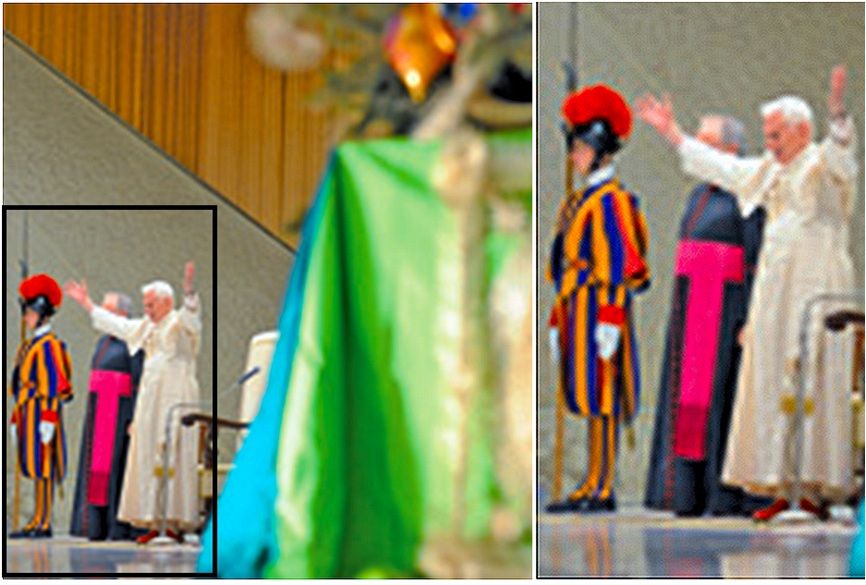 At left is a photo from today's GA used in the back page of tomorrow's issue of the OR (1/3/13), in which I have indicated with a black outline the only 'usable' part of the photo that conveys any meaningful visual information (I have enlarged it on the right).
In Photo-Editing 101 which is basic to any print editor, one of the skills that one learns to master right away is the art of 'cropping' a photograph, which has two main objectives: 1) to cut out any part of the photo (also called 'dead space') that does not contribute to the relevant information that the photo is supposed to convey; and 2) in the process, to maximize the size and visibility of the subject and the event you are illustrating. I routinely crop 80 percent of the newsphotos that I find online for precisely these two reasons.
At left is a photo from today's GA used in the back page of tomorrow's issue of the OR (1/3/13), in which I have indicated with a black outline the only 'usable' part of the photo that conveys any meaningful visual information (I have enlarged it on the right).
In Photo-Editing 101 which is basic to any print editor, one of the skills that one learns to master right away is the art of 'cropping' a photograph, which has two main objectives: 1) to cut out any part of the photo (also called 'dead space') that does not contribute to the relevant information that the photo is supposed to convey; and 2) in the process, to maximize the size and visibility of the subject and the event you are illustrating. I routinely crop 80 percent of the newsphotos that I find online for precisely these two reasons.
In this particular case, the area I would have cropped out contains no useful visual information at all - we are not interested in the wall and ceiling of the Aula Paolo VI stage, and we can't even make out what the large figure in right foreground is which dominates the photo. It looks like the back of some figure, probably from a Nativity scene next to the Christmas tree on stage. The fact that you can't even tell what it is simply underscores its utter irrelevance to the photo. The subject of the photograph is the Pope acknowledging the acclamation of the crowd. We know he is doing it from the stage of the Aula Paolo VI. The blank wall-and-ceiling portion, the chair and the undefined figure in the right foreground do not contribute an iota to that action, nor do they provide any 'artistic' frame to the Pope! - There is absolutely no reason to keep them in, especially since they take up almost three-fourths of the photograph! And yet this madness, which violates all common sense (not to mention photo editing rules), happens day in and day out in the pages of the Vatican newspaper, in addition to other habitual violations of Journalism 101. Doesn't editor Vian have any friends in journalism who can charitably call his attention to his very unprofessional shortcomings?
[Modificato da TERESA BENEDETTA 02/01/2013 23:08] |